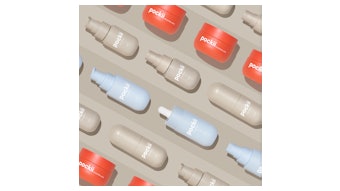
“What components do you have that are sustainable?”
This is the most frequently asked question that our sales representatives are hearing. In these interactions, the client is under the assumption that the question will be followed by a very simple answer. Unfortunately, we believe the question cannot be truly answered until we know what sustainability means to the client who is asking the question.
What Does it Mean to Be Sustainable?
The Merriam-Webster definition of “sustainable” is “of, relating to, or being a method of harvesting or using a resource so that the resource is not depleted or permanently damaged.” This only gets us so far in the packaging conversation.
Note that the definition does not say “only glass is good and plastic is bad, except for PCR (post-consumer recycled) material,” or “paper is better than plastic.” Therefore, a balance is required, not only in the approach but how it fits your brand’s DNA.
Claims, Confusion and Education
Determining this balance for your brand should be simple, right? Unfortunately, what we find is a multitude of claims about being “green,” “eco-friendly,” “refillable” or “sustainable.” In addition, the confusion of what can and cannot be recycled makes it incredibly difficult for brands to determine what balance is best for them.
For example, have you tried eating only organic? It’s not as easy as one would assume, and it tends to be quite expensive. We find being sustainable in the packaging arena can feel just as daunting and expensive. Thankfully, we believe educating brands can help sort through the many myths and inaccuracies surrounding sustainability.
The Plastic Myth
To illustrate the complexity of decisions, it’s important to note that reducing plastic usage may not decrease your carbon footprint if you include more paper or glass.
According to a 2019 explainer from Envirotech Online, “[A]s long as plastic is responsibly recycled, [the] problem [of landfill waste] evaporates. Moreover, the process it takes to create a plastic bottle is far less intense than that which goes into the production of its glass counterpart, meaning that plastic has a far smaller carbon footprint than glassa.”
Glass and paper require even more energy to not only convert from recycling streams, but also cost more to convert back into a package. Going Zero Waste notesb, “Glass is heavier than plastic, and breaks much easier during transit. This means it produces more emissions in transportation than plastic, and costs more to transport.” And a report from Oregon Live addsc, “Paper bags … take more energy to manufacture than plastic, according to some measures.”
Additionally, not all cities recycle glass. A 2018 Recovery Worldwide report notedd, “Global recycling volumes are currently estimated to be around 27 Mta, which represents only 21% of the amount of glass produced. The highest recycling rates are achieved for container glass, with an estimated 32%, while the recycling rate for flat glass is only 11%.”
Brands must ask themselves if turning away from plastic automatically assists them in the maintenance of their eco balance.
The Perception Challenge
There is also a major difference between the perception of sustainability and a true initiative of sustainability. For example, brands and consumers love the look and idea of bamboo on packaging. It screams “sustainable,” “organic,” “eco-friendly,” “all-natural” and “green.”
And, yes, bamboo or natural wood materials are sustainable, but once they are paired with a plastic cap or aluminum bottle, they are no longer easily recyclable. For instance, if a bamboo overshell is glued onto plastic cap and is placed into the recycle bin, it will not be recycled in most municipalities. It will instead be diverted to the landfill since it is a mixed material and the wood cannot be easily separated from the plastic part and sorted properly.
Sustainability Considerations by Material
We understand how confusing this topic is and how many choices and possible trade-offs or compromises you and your brand may have to endure. So, to help you decide on the best sustainable packaging option for your brand, we’ve put together a sustainability primer to bring some clarification on the different material options.
Paper
Is paper recyclable? Yes. That was an easy one. However, paper consumes more fresh water and adds up to three times more carbon emissions into the air over its full lifecycle, compared to plastic.
A Clean Water Action post notese, “[T]he production of paper bags is much more resource intensive in terms of energy and water. About 10% more energy is used to produce a paper bag versus a plastic one, and about four times as much water. Although recycled paper can be used, it takes even more energy and water to go through the recycling process than virgin material, and the finished product is less durable.”
How many times have you heard about a plastic bag ban? We must remember that the plastic bag problem has resulted from the public’s misuse of the bags (littering) and the lack of recycling of these fully recyclable materials.
Again, questions of balance must be raised.
Plastic
Plastics have gotten a bad rap for some good reasons and some not so good ones. Since the early 1950s, the world has produced more than 8.3 billion tons of plastic, 60% of which has ended up in landfills and the natural environment, according to United Nations dataf. Today, the planet still produces 300 million tons of plastic waste annually. This waste can adversely impact wildlife, natural habitats and even drinking water.
The one thing people seem to forget is that all thermoplastics are recyclable, but only about 9% of what we make is actually processedg. Thermoplastic materials can go from raw virgin material to a converted part and back again to a form from which it can be converted again, just like paper or glass. Sadly, there have only been seven true recycle codes for plastics, as shown in F-1 (see April Digital Magazine).
Many in the industry are asking for PCR materials from the seven recycling codes. However, there are also PIR (post-industrial recycled) materials available, which are simply leftover scrap from production that is used in another manufacturing process. These materials never entered the consumer stream and therefore skipped right to recycling. In many cases, it is much easier and affordable to use PIR. Both PIR and PCR stop plastic materials from damaging our environment and stop plastics from piling up in landfills.
Glass
Glass, which is made from silica sand, can be endlessly be recycled. It is important to note, however, that we are using silica sand faster than our planet can replenish it in the near-term.
And, like plastic, we are not recycling enough glass. Like we mentioned earlier, whether it is a city choosing not to recycle glass or a consumer not putting it in the right bin, statistically only about 30% of glass gets recycled. This is technically better than plastics, but still a far cry from our communities being good stewards of our planet.
For the full article, check out Global Cosmetic Industry's April digital magazine.
Footnotes:
awww.envirotech-online.com/news/business-news/44/breaking-news/glass-vs-plastic-which-bottles-are-worse/48297
bwww.goingzerowaste.com/blog/which-is-better-for-the-environment-glass-or-plastic
cMichael Milstein, “Which bag is best: Paper or plastic?” www.zoregonlive.com/environment/2007/05/paper_or_plastic_which_is_best.html
dwww.recovery-worldwide.com/en/artikel/glass-recycling-current-market-trends_3248774.html
ewww.cleanwateraction.org/2018/06/25/paper-or-plastic-why-answer-should-be-%E2%80%9Cneither%E2%80%9D
fwww.unenvironment.org/interactive/beat-plastic-pollution/
gFAQs on Plastics, https://ourworldindata.org/faq-on-plastics#how-much-of-global-plastic-is-recycled
Robert Bulla is the director of engineering and innovation; Shanna Johns is the director of business development of APC Packaging (https://apcpackaging.com/).








![[c] Eye Biotic Micro 15ml Svr Editorial In Use (1) (1)](https://img.gcimagazine.com/files/base/allured/all/image/2025/05/_C__Eye_Biotic_Micro_15ml_SVR_editorial_in_use__1___1_.6813d72ee5edb.png?auto=format%2Ccompress&fit=crop&h=191&q=70&w=340)


